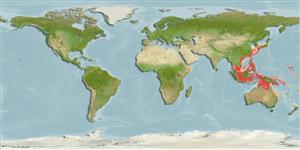Teleostei (teleosts) >
Callionymiformes (Dragonets) >
Callionymidae (Dragonets)
Etymology: Callionymus: Greek, kallion, comparative of kallos = beautiful + Greek, onyma = name; with a better name.
More on author: Fricke.
Environment: milieu / climate zone / depth range / distribution range
Ecology
Marine; demersal; depth range ? - 88 m (Ref. 11897). Temperate
Western Pacific: southern Japan and the South China Sea. More recently reported from the Chesterfield Islands (Ref. 11897).
Size / Weight / Age
Maturity: Lm ? range ? - ? cm
Max length : 17.0 cm SL male/unsexed; (Ref. 559)
Dorsal spines (total): 4; Dorsal soft rays (total): 9; Anal spines: 0; Anal soft rays: 9. First dorsal spine elongate. Tip of anterior branch of last dorsal ray unbranched. First dorsal fin of female with oblong black mark. Anterodorsal corner of 2nd dorsal fin with black mark in the male. Lower margin of anal fin orange with many blue oblique lines in the male, black in the female. Attains 17 cm SL.
Found in shelf edges (Ref. 43239).
Life cycle and mating behavior
Maturity | Reproduction | Spawning | Eggs | Fecundity | Larvae
Kulbicki, M., J.E. Randall and J. Rivaton, 1994. Checklist of the fishes of the Chesterfield Islands (Coral Sea). Micronesica 27(1/2):1-43. (Ref. 11897)
IUCN Red List Status (Ref. 130435: Version 2024-2)
Threat to humans
Harmless
Human uses
Fisheries: bycatch
Tools
Special reports
Download XML
Internet sources
Estimates based on models
Preferred temperature (Ref.
123201): 24.2 - 28.8, mean 27.8 °C (based on 350 cells).
Phylogenetic diversity index (Ref.
82804): PD
50 = 0.5000 [Uniqueness, from 0.5 = low to 2.0 = high].
Bayesian length-weight: a=0.00891 (0.00410 - 0.01937), b=2.78 (2.60 - 2.96), in cm total length, based on LWR estimates for this Genus-body shape (Ref.
93245).
Trophic level (Ref.
69278): 3.3 ±0.4 se; based on size and trophs of closest relatives
Resilience (Ref.
120179): Medium, minimum population doubling time 1.4 - 4.4 years (Preliminary K or Fecundity.).
Fishing Vulnerability (Ref.
59153): Low vulnerability (11 of 100).
